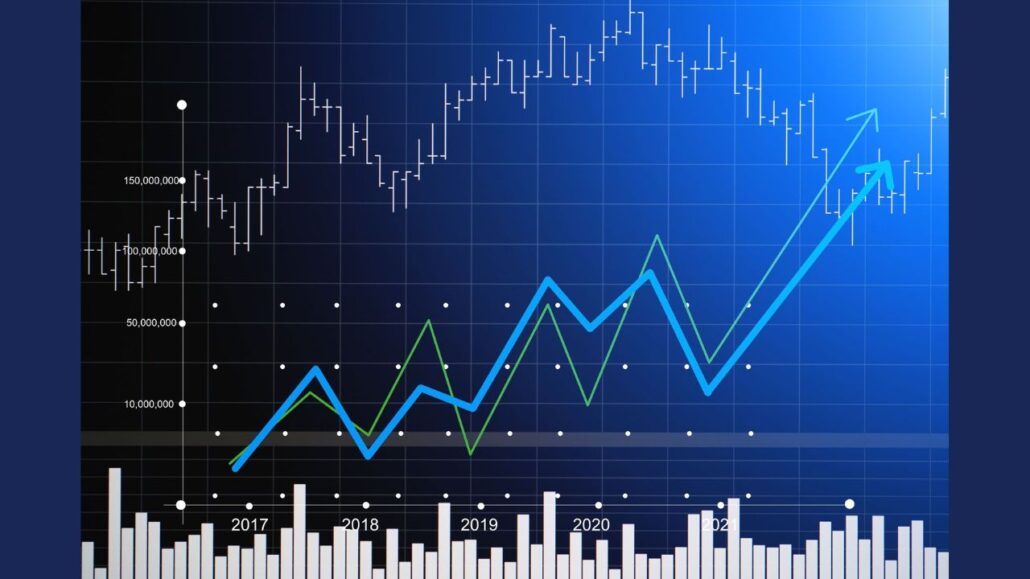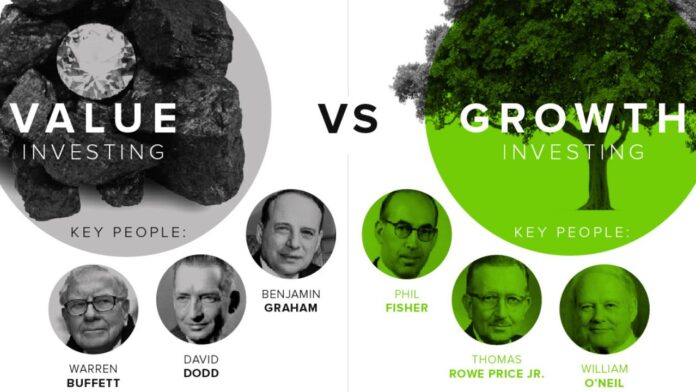Value investing seeks undervalued stocks with solid fundamentals, focusing on intrinsic value and potential for capital appreciation. Growth investing prioritizes companies with high earnings growth potential, often overlooking current valuation. Both strategies aim for long-term gains but differ in their approach to assessing and selecting stocks.
What is Value Investing?
Value investing, popularized by renowned investor Benjamin Graham and later refined by Warren Buffett, focuses on identifying undervalued stocks trading below their intrinsic value.
Value investors seek to purchase stocks at a discount compared to their intrinsic worth, believing that the market has temporarily undervalued these companies.
What is Growth Investing?
On the other hand, growth investing involves selecting stocks of companies expected to experience substantial growth in revenue, earnings, or market share.
Growth investors prioritize companies with strong growth potential, even if their current stock prices may seem expensive relative to traditional valuation metrics.
Key Differences Between Value Investing and Growth Investing
Definition and Objectives
Value investing aims to find bargains in the market by purchasing stocks trading below their intrinsic value, emphasizing the safety of principal and preservation of capital.
In contrast, growth investing seeks companies with robust growth prospects, often willing to pay a premium for high-growth stocks with the anticipation of significant future returns.
Investment Approach
Value investors employ a conservative and patient approach, focusing on fundamental analysis, financial metrics, and margin of safety. They typically invest in established companies with stable earnings and dividends.
On the other hand, growth investors adopt a more aggressive approach, emphasizing future growth potential over current valuation metrics. They often invest in emerging industries or disruptive technologies.
Risk and Volatility
Value investing tends to be less volatile than growth investing since value stocks are often perceived as safer investments due to their lower valuation multiples and established track records.
However, value stocks may also face challenges in a rapidly changing market environment. Growth investing, while offering the potential for higher returns, comes with higher volatility and greater risk, especially during market downturns or when growth expectations are not met.
Time Horizon
Value investing typically has a longer time horizon, with investors willing to hold undervalued stocks for extended periods until the market recognizes their true value.
In contrast, growth investing often involves shorter time horizons, as investors expect rapid growth and may quickly exit positions if growth expectations still need to be met.
Types of Companies
Value investors favor mature, stable companies with consistent earnings and dividends, often found in traditional industries such as utilities, consumer goods, and financial services.
Growth investors, on the other hand, target companies with innovative products, disruptive technologies, or emerging markets that offer the potential for rapid expansion and market dominance.
Valuation Metrics
Value investors focus on valuation metrics such as price-to-earnings ratio (P/E), price-to-book ratio (P/B), and dividend yield to assess whether a stock is undervalued relative to its intrinsic worth.
Growth investors may prioritize metrics like price-to-sales ratio (P/S), earnings growth rate, and total addressable market (TAM) to identify companies with strong growth potential, even if current valuations appear high.
Investor Psychology
Value investing is grounded in the principle of contrarianism, where investors capitalize on market inefficiencies and investor emotions, such as fear and greed.
Value investors exhibit patience and discipline, often buying when others are selling and selling when others are buying.
Growth investing, on the other hand, may attract investors driven by optimism, excitement, and the fear of missing out (FOMO), leading to higher levels of speculation and volatility.
Advantages and Disadvantages of Value Investing
Pros
- Potentially lower risk due to conservative investment approach
- Emphasis on intrinsic value provides downside protection
- Historical track record of success by legendary investors like Warren Buffett
Cons
- Limited upside potential compared to growth stocks
- Requires patience and discipline during market downturns
- Value traps: undervalued stocks may remain stagnant or decline further
Advantages and Disadvantages of Growth Investing
Pros
- Higher growth potential and capital appreciation
- Opportunity to invest in innovative and disruptive companies
- Exciting investment opportunities in emerging industries
Cons
- Higher volatility and risk of market corrections
- Reliance on future growth expectations, which may not materialize
- Valuation concerns: growth stocks may be overvalued and susceptible to market sentiment shifts
Which One is Better: Value Investing or Growth Investing?

The choice between value investing and growth investing ultimately depends on an individual investor’s financial goals, risk tolerance, and investment horizon.
Both strategies have their merits and drawbacks, and some investors may even choose to combine elements of both approaches in their investment portfolio.
Value investing appeals to investors seeking stability, consistent returns, and a margin of safety during market downturns.
On the other hand, growth investing attracts those looking for higher growth potential, willing to tolerate higher levels of risk and volatility in pursuit of significant capital appreciation.
The Essence of Value Investing
Value Investing, characterized by meticulous scrutiny, revolves around identifying stocks that the market has undervalued.
Investors employing this strategy seek out companies with strong fundamentals but are currently priced below their intrinsic value.
This approach emphasizes a patient and disciplined mindset, allowing investors to capitalize on the market’s occasional mispricing.
Navigating the Landscape: Key Aspects of Value Investing
- Fundamental Analysis
Value investors delve deep into a company’s financials, studying metrics such as earnings, dividends, and book value. This rigorous fundamental analysis is the bedrock of their decision-making process.
- Margin of Safety
Central to the value investing philosophy is the concept of a margin of safety. Investors aim to buy stocks at a significant discount to their intrinsic value, providing a buffer against market volatility.
The Thrill of Growth Investing
Contrary to the conservative nature of value investing, growth investing embraces the dynamism of burgeoning companies with the potential for substantial expansion.
Investors in this realm prioritize stocks that exhibit rapid revenue and earnings growth, even if the current market valuation appears steep.
Core Tenets of Growth Investing
- Emphasis on Future Potential
Growth investors look beyond current financials and focus on a company’s prospects. They evaluate companies based on high revenue growth, innovative products, and expanding market share.
- Acceptance of Higher Risk
In the pursuit of substantial returns, growth investors accept a higher level of risk. This strategy acknowledges that not all high-growth companies will thrive, and some may face setbacks.
Choosing the Right Path: A Strategic Decision
The decision between value and growth investing is not a one-size-fits-all choice. Investors must consider their risk tolerance, time horizon, and financial goals before aligning with a particular strategy.
Some may find solace in the stability of value investing, while others are drawn to the adrenaline of growth investing.
Wrapping Up the Investment Odyssey
The fundamental disparities between value and growth investing are pivotal for anyone venturing into the stock market. Each strategy has its merits and drawbacks, and the optimal choice depends on an investor’s individual preferences and risk appetite.
Conclusion
The difference between value investing and growth investing lies in their respective investment philosophies, objectives, and risk-reward profiles. Value investing prioritizes the safety of principal and purchasing undervalued stocks, while growth investing focuses on capitalizing on high-growth opportunities and future earnings potential. Both strategies have their place in a well-diversified investment portfolio, and understanding the distinctions between them can help investors make informed decisions aligned with their financial objectives.
FAQ
Growth vs Value Investing: Which Is Best For You?
Difference Between Value Investing vs Growth Investing, Comparison of Value and Growth Investing. Value investing focuses on older companies that are undervalued, while growth investment looks for businesses that are expanding their sales, profits, or cash flow at a quicker rate than normal.
What are Value Stocks?
Difference Between Value Investing vs Growth Investing, Value stocks are those that are not yet trading at the full inherent value of the company. In essence, it indicates that the equities are good investment options because they are undervalued, or that they are traded at a price below their true value.
Do Growth or Value Stocks Perform Better?
In the long run, value investing has historically beaten growth investing. More recently, however, growth investing has been demonstrated to beat value investing. According to a recent article, growth investing has done better than value investing in the last 25 years.
Value or Growth Stocks: Which Is Better?
Value stocks typically perform better in down markets and recessions, whereas growth companies typically perform better in bull markets or times of economic prosperity. This is something that investors with shorter time horizons or those looking to time the markets should consider.



